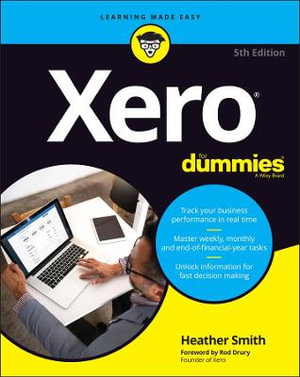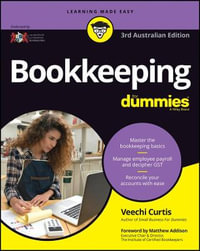
At a Glance
496 Pages
23.5 x 18.5 x 3.5
Paperback
RRP $39.95
$31.75
21%OFF
or 4 interest-free payments of $7.94 with
orShips in 5 to 7 business days
Your comprehensive guide to using Xero
Keeping your business running smoothly has never been easier with Xero. You’re in good hands with Xero For Dummies, the only book endorsed by Xero. With the tips and tricks included in this helpful guide, you can easily tackle tasks like accounts payable, invoices, and estimates. It’s packed with easy to follow explanations and instructions on how to use this popular accounting software. It’s like having a personal accountant at your fingertips!
The latest update to this useful reference shows how you can use Xero for more than a simple spreadsheet. It includes how to set up your account from scratch, convert your business from another accounting software to Xero, and use Xero to its full potential. It includes these essential topics:
- Customize the Xero set-up for your business
- Manage your daily activities with contacts, accounts, sales, and payables
- Organize suppliers and customers
- Automate your weekly and monthly reporting routines
- Track inventory and monitor your business
- Sync seamlessly across other business platforms
Filled with real-world scenarios that shows how you can use Xero every day in your business, Xero For Dummies can help you get your paperwork done quickly, so you can spend your valuable time running your business. Pick up your copy of Xero For Dummies to make that your reality.
About the Author
Heather Smith is a small-business commentator who writes for national online and printed publications, including the Daily Telegraph, Flying Solo, ninemsn, Woman’s Day, and the Courier-Mail. She is a Fellow and an Ambassador of the Association of Chartered Certified Accountants (ACCA). Heather is a Xero and MYOB consultant and the author of Learn Small Business Start-Up in 7 Days and Learn MYOB in 7 Days. She is the Founding Director of ANISE Consulting, a boutique consultancy company that provides business support in Brisbane, Australia.
Introduction 1
Part 1: Getting Started with Xero 7
Chapter 1: Getting to Know Xero 9
Chapter 2: Getting Organised: Setting Up Xero from Scratch 25
Chapter 3: Converting to Xero from Another System 63
Chapter 4: Fine-tuning Your Set-Up 91
Part 2: Daily Activities 115
Chapter 5: Managing Your Contacts 117
Chapter 6: Managing Your Sales 137
Chapter 7: Managing Your Payables 183
Chapter 8: Reconciling Your Bank Accounts 221
Part 3: Making the Routine, Routine 257
Chapter 9: Generating Reports 259
Chapter 10: Mastering Your Weekly and Monthly Tasks 279
Chapter 11: End of Financial Year Reporting 315
Part 4: Getting the Most Out of Xero 331
Chapter 12: Monitoring Your Business 333
Chapter 13: Managing Your Inventory Items 379
Chapter 14: Working with Fixed Assets 393
Chapter 15: Working with Multi-Currency Transactions 409
Chapter 16: Exploring the Xero Marketplace 423
Part 5: The Part of Tens 439
Chapter 17: Ten (Plus One!) Tips for Long-Term Success with Xero 441
Chapter 18: Ten Common Mistakes Made in Xero and How to Avoid Them 447
Index 453
Introduction 1
About This Book 2
Foolish Assumptions 3
Icons Used in This Book 4
Where to Go from Here 4
Part 1: Getting Started with Xero 7
Chapter 1: Getting to Know Xero 9
Understanding the Advantages of Xero 10
Exploring Xero’s Different Editions 13
Homepage: Checking Out the Dashboard 16
Understanding Your Team’s Needs 17
Integrating Xero into Your Strategic Planning 21
Generating accurate, complete and timely data entry 21
Introducing Management Reporting and the analysis capabilities of Xero 22
Taking Advantage of Support Options 22
Using Xero in a Training Environment 23
Chapter 2: Getting Organised: Setting Up Xerofrom Scratch 25
Preparing for Set-Up 26
Checking your browser and system requirements 26
Collecting your business data 28
Signing Up for Xero 29
Getting started 30
Organisation Settings 34
Financial Settings 36
Understanding Bookkeeping Basics 38
Working out how account types affect your reports 39
Creating a chart of accounts that works for you 42
Developing your own chart of accounts 43
Setting Up Your Chart of Accounts 45
Using Xero’s default Chart of Accounts 45
Customising your chart of accounts 46
Putting Your Accounts into Practice 50
Checking your conversion balances 50
Adding comparative balances 52
Entering historical invoices, bills and credit notes 54
Adding Ways to Get Paid 55
Setting up bank accounts 55
Including credit cards 57
Online payment options 57
Tax Rates 58
Chapter 3: Converting to Xero from Another System 63
Preparing to Import Data from a Non-Accounting Program 64
Converting paper-based records 64
Working with spreadsheets 65
Getting Ready to Convert from an Accounting Program 65
Getting ready to convert 67
Converting exported CSV files into Excel 70
Preparing data for import 73
Mapping tax rates 75
Importing Data into Xero 75
Chart of accounts 76
Contacts 78
Inventory items 79
Sales 81
Purchases 82
Bank transactions 84
Manual journals 86
Fixed assets 87
Unpresented payments or uncleared funds 88
Turning Off Your Old System 89
Accessing historical data 89
Moving to the new system 89
Confirming the switchover date 90
Chapter 4: Fine-tuning Your Set-Up 91
Tools of the Trade: Understanding the Dashboard 92
Xero balance versus bank balance 93
Total Cash In and Out 94
Account Watchlist 94
Invoices Owed to You 95
Bills You Need to Pay 96
Dealing with expense claims 96
Setting Up Users 96
Understanding user access levels 96
Inviting other users to access Xero 98
Taking Advantage of Live Bank Feeds 102
Activating live bank feeds 102
Organising bank accounts on your dashboard 105
Managing bank feeds 106
Manually Importing Statements 107
Bank Rules 107
Setting up bank rules 108
Managing bank rules 111
Using File Storage and the Xero Inbox 112
Part 2: Daily Activities 115
Chapter 5: Managing Your Contacts 117
Setting Up Customers 118
Setting Up Suppliers 126
Connecting Your Contacts to Workspace or Office 365 126
Sync Xero contacts with Google contacts and Microsoft Outlook 126
Connecting your email account to your contacts 127
Tweaking Your Contacts after Set-Up 128
Finding your contacts 128
Managing your contacts 129
Grouping your contacts 130
Merging your contacts 130
Unpicking accidentally merged contacts 131
Archiving your outdated contacts 132
Setting Up Employees 132
Utilising Smart Lists CRM Functionality 134
Chapter 6: Managing Your Sales 137
Navigating the Sales Dashboard 138
Money Coming In 141
Customers Owing the Most — list 141
Customers Owing the Most — pie chart 141
Mastering Basic Invoice Functions 141
Creating a new sales invoice 142
Accessing additional functionality in New invoice style 146
Saving, approving and cancelling invoices 147
Sending an invoice to a customer 149
Mastering More Advanced Invoice Functions 153
Designing clear invoices for a positive cash flow 154
Working with repeating invoices 162
Invoicing contact groups 164
Managing credit notes 165
Creating a new quote 167
Recording Payments 169
Receipting against sales invoices 169
Sending receipts 170
Recording income for a simple cash business 170
Making use of batch payments 172
Removing allocated payments 174
Taking Advantage of Email Templates 174
Defining your user email addresses 175
Creating a new email template 176
Deleting customised templates 178
Connecting with contacts via social media 178
Following Up on Outstanding Debtors 179
Setting up invoice reminders 180
Making use of statements 181
Chapter 7: Managing Your Payables 183
Navigating the Purchases Dashboard 184
Managing Your Supplier Bills 187
Creating a new bill 187
Approving and cancelling bills 191
Generating a purchase order 193
Making Payments 196
Recording an individual payment 196
Recording batch payments 198
Removing allocated payments 201
Mastering Other Payment Considerations 202
Printing bills 202
Working with Repeating Bills 202
Scheduling payments 204
Stylising your check 205
Sending remittance advice 207
Managing credit notes 208
Taking advantage of Hubdoc 209
Entering Expense Claims 209
Understanding Xero Expenses functionality 210
Defining Expense Settings 212
Adding a new expense claim 213
Making mobile expense claims 215
Submitting a claim for approval 217
Reviewing and authorising the claim 217
Paying the claim 218
Adding a new mileage claim 219
Chapter 8: Reconciling Your Bank Accounts 221
Preparing to Reconcile 222
Automagically Reconciling Accounts 224
Understanding the hierarchy for matching 225
Accepting transactions Xero has matched correctly 225
Tweaking Transactions to Reconcile 229
Matching misfit transactions 229
Create 234
Transfer 235
Discuss 235
Reviewing other possible matches 236
Taking Advantage of Cash Coding 236
Getting familiar with Cash Coding 237
Understanding bulk coding 238
Viewing Bank Statements 240
Viewing Account Transactions 241
Using the Spend Money and Receive Money Options 242
Direct payment 243
Prepayment 244
Overpayment 244
Underpayment 244
Processing prepayments and overpayments 245
Searching for a transaction 245
Fixing Errors 246
Resolving the difference between Xero balances and bank balances 247
Undertaking detailed searches to find and recode transactions 249
Unreconciling a bank transaction 253
Removing and undoing a bank transaction 254
What Happens in Life Happens in Xero 254
Part 3: Making the Routine, Routine 257
Chapter 9: Generating Reports 259
Understanding the Reports Available in Xero 259
Accessing Xero’s business reports 260
Selecting your favourite reports 265
Sorting and filtering 266
Customising Reports 267
Customising report layouts 267
Adding reporting ‘bling’: Text Blocks and Footnotes 272
Changing views 274
Understanding Xero’s Different Reporting Options 274
Draft 274
Published 275
Archived 276
Exporting Reports 276
Accessing Management Reports 277
Chapter 10: Mastering Your Weekly and Monthly Tasks 279
Confirming Accounts are Complete 280
Reconciling Bank Accounts, Credit Card and Online Payment Gateway Accounts 281
Checking Off the Transactions in Your Clearing Accounts 283
Reconciling Your Consumer Tax Control Account 284
Reviewing Your Business Information 287
General Ledger Exceptions report 287
Invoicing 287
Aged Receivables 288
Aged Payables 290
Reporting to Your Tax Authority 291
Australian reporting 292
Canadian reporting 296
New Zealand reporting 298
Singapore reporting 301
South Africa reporting 302
US reporting 303
UK reporting 306
Recording payments to your tax authority 309
Taking Advantage of Xero’s Budget Functions 310
Creating a budget 311
Reviewing and editing your budget 313
Setting a Period Lock Date 314
Chapter 11: End of Financial Year Reporting 315
Getting Ready for the End of the Financial Year 316
Finding out where you’re at 316
Being prepared early 317
Reconciling tax payments for the year 318
Processing a bad debt 318
Preparing Accounts for Your Tax Accountant 319
Helping with Tax Accountant Tasks 324
Enabling your tax accountant to work directly in Xero 325
Exporting general ledger transactions 325
Entering manual journals 326
Special Considerations 329
Publishing end-of-year reports 329
Locking down accounts 329
Part 4: Getting the Most Out of Xero 331
Chapter 12: Monitoring Your Business 333
Identifying Key Metrics 334
Using Xero to set realistic targets and strategies 335
Setting KPIs and rewarding success 336
Reviewing your business strategy 337
Generating Useful Information 338
Taking advantage of management reports 338
Delving deeper into the Executive Summary report 341
Assessing your performance 345
Evaluating your position 346
Unpicking the details 346
Customising the Management Report 346
Unravelling the Business Performance dashboard 348
Exploring the Analytics Plus Reports 352
The Business Snapshot report 352
Short Term Cash Flow 353
Understanding Xero’s Tracking Options 354
Using Tracking 355
Working out what your business should track 355
Setting up Tracking 356
Editing, deleting and applying Tracking options 357
Reviewing Tracking reports 358
Tracking conversion balances 359
Maintaining Budget Control: Budget Manager 361
Exploring Xero Projects 362
Defining Project Settings 364
Adding a new Project 365
Adding a Project Task 367
Adding a Project Expense 368
Recording a Time Entry 371
Raising a Deposit Invoice for a Project 373
Invoicing billable Tasks & Expenses 374
Raising a Project Invoice 375
Tracking Project time entries from your mobile device 375
Project reporting 377
Chapter 13: Managing Your Inventory Items 379
Understanding Inventory Items 380
Periodic and perpetual inventory 380
Defining inventory accounts 381
Setting Up a Xero Inventory Item 382
Creating inventory items 382
Importing and exporting item details and importing opening balances 385
Managing Inventory Items 385
Making use of inventory items reports 385
Searching for and reviewing inventory items 386
Editing and deleting inventory items 386
Adjusting Inventory Balances 388
Periodic stocktakes 388
Adjusting untracked inventory values 389
Adjusting tracked inventory quantities 390
Adjusting tracked inventory values 391
Accessing Online App Solutions 392
Chapter 14: Working with Fixed Assets 393
Recognising Fixed Assets 393
Entering a fixed asset into the register 394
Dealing with depreciation 401
Tax reporting and asset pooling 403
Selling or removing a fixed asset from the register 403
Accessing Fixed Asset Reports 406
Chapter 15: Working with Multi-Currency Transactions 409
Setting Up Multi-Currency in Xero 410
Upgrading your Xero plan 410
Adding currencies to Xero 410
Processing Multi-Currency Transactions in Xero 412
Understanding tax rates 412
Working with foreign currency exchange rates 413
Creating a foreign currency invoice 413
Purchasing in a foreign currency 418
Conversion Balances and Multi-Currency Bank Accounts 420
Viewing Reports in Foreign Currency 420
Chapter 16: Exploring the Xero Marketplace 423
Working with Xero to Xero Networks 424
Understanding the Benefits and Risks of Cloud App Solutions 425
What to look for when choosing an app 425
Ascertaining implementation costs 426
Working out if the solution is right for you 427
Looking at longevity 427
Checking response times 428
Understanding data usage and security 428
Making Use of Online Cloud Integration Specialists 428
Getting a Feel for Available Solutions 429
Connectors 430
CRMs 431
Debtor tracking 431
e-commerce 432
Bills and expenses 432
Inventory 432
Job tracking 433
Payments 434
Documents 434
Payroll 435
Point of sale 435
Financial services 436
Time tracking 436
Reporting 436
Looking at Custom Integration 437
Part 5: the Part of Tens 439
Chapter 17: Ten (Plus One!) Tips for Long-Term Success with Xero 441
Embrace the Cloud 442
Make Use of Networking Technology and Apps 442
Export and Visually Organise Data 442
Set up Bank Feeds and Reconcile Regularly 443
Use the Batch Payments Feature 443
Keep Bank Accounts for Business Use 444
Embrace Change 444
Use Tracking to Enhance Reporting Options 444
Take Advantage of Repeating Bills and Invoices 445
Collaborate with Your Xero Advisory Team 445
Effectively Tap into Online Storage Features 446
Chapter 18: Ten Common Mistakes Made in Xero and How to Avoid Them 447
Not Making Use of Expert Help 447
Not Understanding Terminology Differences 448
Messing Up Bank Reconciliation Autosuggestions 449
Using a Communal User Account 449
Not Deleting Old User Accounts 449
Thinking Your Xero Emails Are Stored 450
Not Realising the Subscriber Owns and Controls the Data 450
Trying to Make Xero Do What Your Old System Did 451
Watching Your Bank Feeds Refresh 451
Paying Full Price If You’re a NFP 451
Index 453
ISBN: 9780730394617
ISBN-10: 0730394611
Series: For Dummies (Business & Personal Finance)
Published: 1st June 2022
Format: Paperback
Language: English
Number of Pages: 496
Audience: General Adult
Publisher: John Wiley & Sons Australia
Country of Publication: GB
Edition Number: 5
Dimensions (cm): 23.5 x 18.5 x 3.5
Weight (kg): 0.81
Shipping
| Standard Shipping | Express Shipping | |
|---|---|---|
| Metro postcodes: | $9.99 | $14.95 |
| Regional postcodes: | $9.99 | $14.95 |
| Rural postcodes: | $9.99 | $14.95 |
Orders over $79.00 qualify for free shipping.
How to return your order
At Booktopia, we offer hassle-free returns in accordance with our returns policy. If you wish to return an item, please get in touch with Booktopia Customer Care.
Additional postage charges may be applicable.
Defective items
If there is a problem with any of the items received for your order then the Booktopia Customer Care team is ready to assist you.
For more info please visit our Help Centre.
You Can Find This Book In
This product is categorised by
- Non-FictionAccounting & FinanceAccounting
- Non-FictionBusiness & ManagementBusiness Strategy
- Non-FictionSelf-Help, Personal Development & Practical AdviceHow-toFor Dummies BooksBusiness & Finance Accounting
- Non-FictionSelf-Help, Personal Development & Practical AdviceHow-toFor Dummies BooksBusiness & Finance Business Productivity
- Non-FictionSelf-Help, Personal Development & Practical AdviceHow-toFor Dummies BooksBusiness & Finance Small Business
- Non-FictionSelf-Help, Personal Development & Practical AdviceHow-toFor Dummies BooksTop 50 at 30% off















